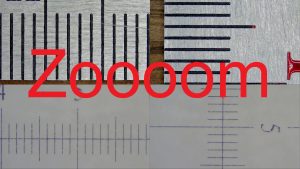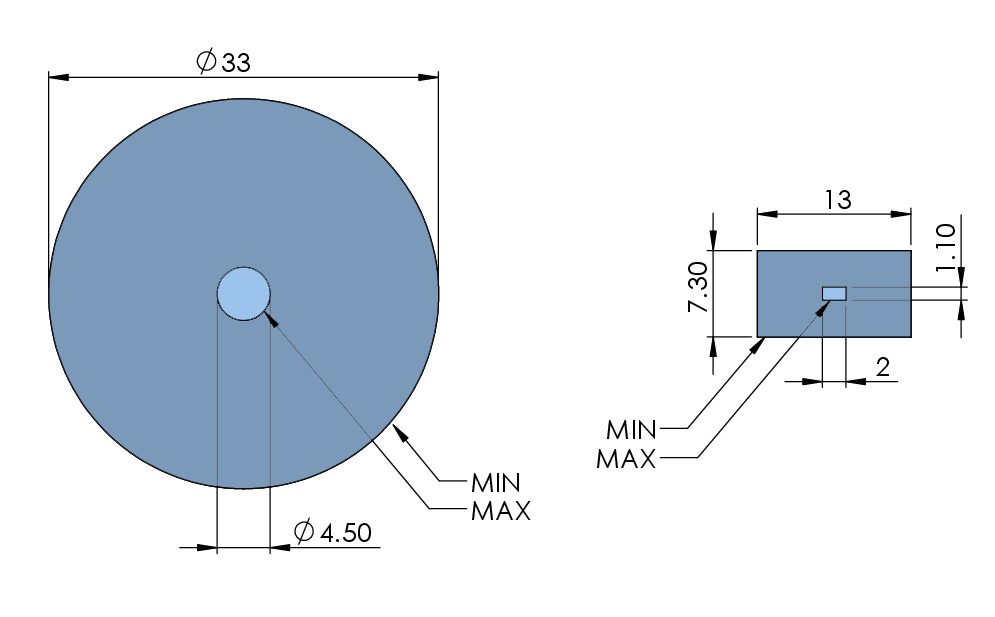
 Magnification ratio is one of many parameters to describe optical instrument – microscope in this case. Magnification ratio usually comes along with zoom range. These terms are often being misused. In this post I will measure zoom range and magnification ratio of monocular video microscope lens and stereo inspection microscope (Konus #5424) head.
Magnification ratio is one of many parameters to describe optical instrument – microscope in this case. Magnification ratio usually comes along with zoom range. These terms are often being misused. In this post I will measure zoom range and magnification ratio of monocular video microscope lens and stereo inspection microscope (Konus #5424) head.
Despite being different kind of optical instruments they have similar magnification ratios, so it’s fair to compare them.
Measurement
Let’s mount C1 camera on a lens and take some pictures of a known object at minimal and maximal magnification.
Two different rulers will be used:
- Larger one is 50cm steel ruler
- Smaller one is microscope slide 5mm with 0.01mm marks
I will use these pictures to measure view field dimensions. Also to be noted that video microscope uses 0.5x adapter tube.
Declared min magnification: (0.7x * 0.5) 0.35x -> 13mm(H) x 7.3mm(V) Declared max magnification: (4.5x * 0.5) 2.25x -> 2mm(H) x 1.1mm(V)
Math – zoom ratio
Quickly calculate diagonal viewable image size at min and max magnification:
SQRT(13^2 + 7.3^2) = 14.9mm SQRT(2^2 + 1.1^2) = 2.3mm
And now we can find zoom ratio:
Theoretical: (4.5*0.5) / (0.7*0.5) = 6.4x Zoom ratio: 14.9 / 2.3 = 6.5x
So stated magnification ratio is pretty legit. Good to know that manufacturer does not lie.
For reference I also measured trinocular microscope viewable image size at minimal and maximal magnification ratio. Please note that this time I measured rulers by eye and projected image is disc instead of being rectangular.
Declared min magnification 0.7x: D=33mm Declared max magnification 4.5x: D=4.5mm Zoom ratio: 33/4.5 = 7.3x
While specified parameters are the same magnification range is slightly wider than previous optical instrument.
Math – magnification
While we can’t measure stereo microscope magnification (don’t have projected image dimensions), it is pretty easy to calculate this parameter for lens mounted on a camera. To calculate this parameter we need to know used camera sensor dimensions. Good to know that C1 camera has known sensor dimensions.
Sensor size horizontal: 5.07mm(H) Sensor size horizontal: 3.38mm(V) Sensor size diagonal: SQRT(5.07^2 + 3.38^2) = 6.09mm
Also let’s take into account that camera does not use full sensor.
Pixel dimensions: 2.2µm x 2.2µm (square pixels) Frame size: 1920 x 1080 True frame size horizontal: 1920 * 2.2µm = 4.224mm True frame size vertical: 1080 * 2.2µm = 2.376mm True frame size diagonal: SQRT(4.224^2 + 2.376^2) = 4.85mm
Now when we have source and destination image sizes let’s normalize them to have nice magnification ratio
Min magnification: 4.85 / 14.9 = 0.33 = 1:3 Max magnification: 4.85 / 2.28 = 2.12 = 2:1
Simplified animated illustration shows projected image size variations.
Compare results
To compare viewable area of both microscopes I provide you drawing.
While both compared microscopes have specified range of 0.7x-4.5x they have slightly different optical parameters. At a first glance video microscope has smaller view area, but it might be deceptive conclusions. Actually being C-mount it is suitable for larger sensors. How big? It might be between 1″ and 1/2″.
















